
Much like the multi-coloured sticker on new appliances, Energy Performance Certificates (EPCs) tell you how energy efficient a building is.
EPCs rate a home from A (very efficient) to G (inefficient). They’ll tell you how costly it will be to heat and light your property, and what its carbon dioxide emissions are likely to be.
An EPC also includes information on what the energy efficiency rating could be if you made the recommended improvements. It also highlights cost effective ways to improve your EPC rating.
Even if you rent your home, you could still implement some improvements noted on the EPC, such as switching to more energy efficient light bulbs.
EPCs are valid for 10 years from the date of issue.

If you’re looking to sell or rent out your home, you need an EPC before it goes on the market. You must get an approved domestic energy assessor to produce the EPC.
If you’re looking for a property to buy or rent a property, the EPC lets you compare the energy efficiency of different properties easily. Properties in Scotland must display its EPC rating, for example, near the boiler or meter cupboard.
The EPC also gives recommendations to improve your rating. If you do make any energy efficiency recommendations outlined in your EPC, you may want to get a new EPC to reflect this.
It’s worth noting that not all EPCs look the same. In this guide, we are using a 2017 certificate as an example. Older certificates will have most of this information, although it may look a bit different and may be in a different order.
Please note that EPCs in England, Wales and Northern Ireland have moved to a new format. This format looks different to the example we have used here from Scotland. The sections and information covered are identical.
 spend on heating stands at £4,083. Potential cots are 1, 302 over three years. When it comes to hot water, this household would spend £1,206 over three years. As for potential costs over three years on hot water is £237. The total current costs for lighting, heating, and hot water amounts to £5,670. The total potential costs for lighting, heating, and hot water amounts to £1,830. In regards to potential future savings, you could save £3,840 over three years. " width="699" height="254" />The first page of your EPC starts with an estimate of the current and potential energy bills of the property. This is useful for knowing how much a new property will cost to run in energy bills. It’s also helpful for knowing how much lower the running costs could be if the energy efficiency was improved. These costs are just for your heating, hot water and lighting. The EPC doesn’t include any additional energy costs from your home appliances (eg the cost of running home appliances like your fridge). In reality, your energy bills will be a bit higher. However, the costs shown can help you compare properties and see which building could be cheaper to run. In this example, the potential savings add up to nearly £4,000 over three years in this three-bedroom semi-detached house. Energy efficiency rating
spend on heating stands at £4,083. Potential cots are 1, 302 over three years. When it comes to hot water, this household would spend £1,206 over three years. As for potential costs over three years on hot water is £237. The total current costs for lighting, heating, and hot water amounts to £5,670. The total potential costs for lighting, heating, and hot water amounts to £1,830. In regards to potential future savings, you could save £3,840 over three years. " width="699" height="254" />The first page of your EPC starts with an estimate of the current and potential energy bills of the property. This is useful for knowing how much a new property will cost to run in energy bills. It’s also helpful for knowing how much lower the running costs could be if the energy efficiency was improved. These costs are just for your heating, hot water and lighting. The EPC doesn’t include any additional energy costs from your home appliances (eg the cost of running home appliances like your fridge). In reality, your energy bills will be a bit higher. However, the costs shown can help you compare properties and see which building could be cheaper to run. In this example, the potential savings add up to nearly £4,000 over three years in this three-bedroom semi-detached house. Energy efficiency rating 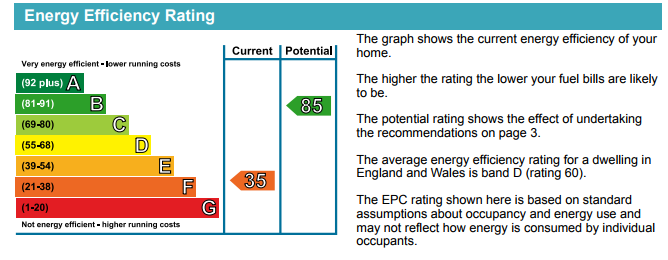 The next table you see on page one is a quick visual comparison of property performance similar to the energy labels you get on home appliances. Your property has a current energy efficiency rating. These range from A-G, with A being the best. Some EPCs also have a similar chart for a property’s environmental performance. It also shows the potential rating if you carry out all the suggested improvements. In this example, you can see that the home could jump from band F to B with the recommended energy efficiency upgrades. Top actions
The next table you see on page one is a quick visual comparison of property performance similar to the energy labels you get on home appliances. Your property has a current energy efficiency rating. These range from A-G, with A being the best. Some EPCs also have a similar chart for a property’s environmental performance. It also shows the potential rating if you carry out all the suggested improvements. In this example, you can see that the home could jump from band F to B with the recommended energy efficiency upgrades. Top actions 
 rating was 2 stars When it comes to lighting, the property had low lighting in 7% of fixed outlets, the energy efficiency rating was one star " width="706" height="275" />This page gives you a detailed breakdown of each element of your property. Each element includes a description and an energy rating from one to five stars (with five being the best). This is to help you understand the effectiveness of its construction, heating and hot water system, and lighting. This can be especially useful for comparing with other properties when you’re looking to buy or rent. Our example has an efficient heating system and some roof insulation, but there’s plenty of room for improvement. Low carbon energy
rating was 2 stars When it comes to lighting, the property had low lighting in 7% of fixed outlets, the energy efficiency rating was one star " width="706" height="275" />This page gives you a detailed breakdown of each element of your property. Each element includes a description and an energy rating from one to five stars (with five being the best). This is to help you understand the effectiveness of its construction, heating and hot water system, and lighting. This can be especially useful for comparing with other properties when you’re looking to buy or rent. Our example has an efficient heating system and some roof insulation, but there’s plenty of room for improvement. Low carbon energy 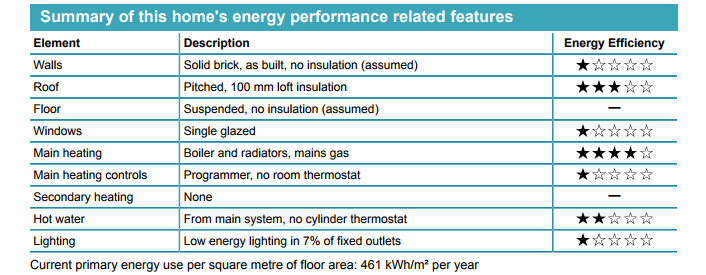 Heat demand
Heat demand 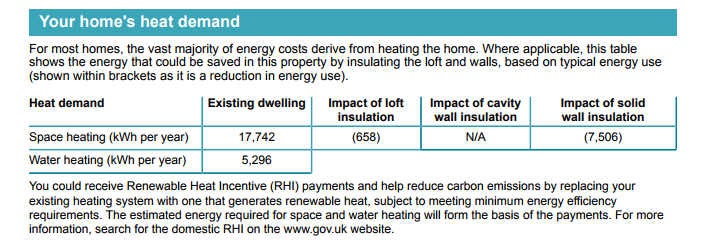 This section looks at how much heat you’re expected to use in the property and how you can reduce that by improving the insulation.
This section looks at how much heat you’re expected to use in the property and how you can reduce that by improving the insulation.
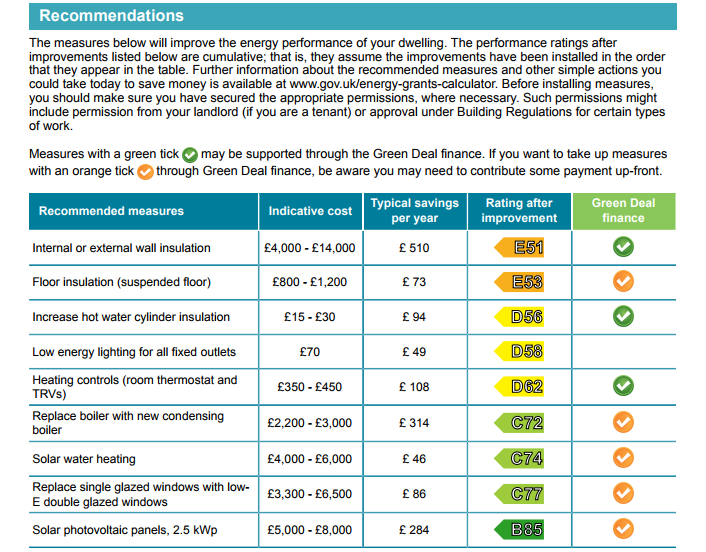 it shows that properties that took recommended measures in terms of internal of external wall insulation, the indicative cost is £4,000 - £14,000. The typical savings per year amount to £510. The rating after improvement is E51 and is supported through Green Deal finance. Floor insulation (suspended floor) has an indicative cost of £800 - £1,200, with typical savings per year amounting to £73. The rating after improvement is E53. If you wanted to take up measures be aware that you may need to contribute to some of the payment up-front. With recommended measures for increases in hot water cylinder insulation, the indicative costs is between £15 - £30. The typical savings per year amount to £94. The rating after improvement is D56. The recommended measures are supported through the Green Deal finance. When it comes to low energy lighting for all fixed outlets, the indicative cost is £70 and the typical savings per year is £49. Rating after improvement is listed as D56. There is no green deal finance with low energy lightning. When it comes to Heating controls (Room thermostat and TRVs) the indicative costs are £350 - £450. The typical saving is £108, and the rating after improvement is listed as D62. The recommended measures are supported through the Green Deal finance. When it comes to Replace boiler with new condensing boiler the indicative costs are £2,200 - £3, 000. The typical saving is £314, and the rating after improvement is listed as C72. If you wanted to take up measures be aware that you may need to contribute to some of the payment up-front. When it comes to Solar water heating the indicative costs are £4,000 - £6, 000. The typical saving is £46, and the rating after improvement is listed as C74. If you wanted to take up measures be aware that you may need to contribute to some of the payment up-front. When it comes to Replace single glazed windows with low-E double glazed windows the indicative costs are £3,300 - £6, 500. The typical saving is £86, and the rating after improvement is listed as C77. If you wanted to take up measures be aware that you may need to contribute to some of the payment up-front. When it comes to Solar photovoltaic panels, 2.5 kWp the indicative costs are £5,000 - £8, 000. The typical saving is £284, and the rating after improvement is listed as B35. If you wanted to take up measures be aware that you may need to contribute to some of the payment up-front. " width="706" height="552" />
it shows that properties that took recommended measures in terms of internal of external wall insulation, the indicative cost is £4,000 - £14,000. The typical savings per year amount to £510. The rating after improvement is E51 and is supported through Green Deal finance. Floor insulation (suspended floor) has an indicative cost of £800 - £1,200, with typical savings per year amounting to £73. The rating after improvement is E53. If you wanted to take up measures be aware that you may need to contribute to some of the payment up-front. With recommended measures for increases in hot water cylinder insulation, the indicative costs is between £15 - £30. The typical savings per year amount to £94. The rating after improvement is D56. The recommended measures are supported through the Green Deal finance. When it comes to low energy lighting for all fixed outlets, the indicative cost is £70 and the typical savings per year is £49. Rating after improvement is listed as D56. There is no green deal finance with low energy lightning. When it comes to Heating controls (Room thermostat and TRVs) the indicative costs are £350 - £450. The typical saving is £108, and the rating after improvement is listed as D62. The recommended measures are supported through the Green Deal finance. When it comes to Replace boiler with new condensing boiler the indicative costs are £2,200 - £3, 000. The typical saving is £314, and the rating after improvement is listed as C72. If you wanted to take up measures be aware that you may need to contribute to some of the payment up-front. When it comes to Solar water heating the indicative costs are £4,000 - £6, 000. The typical saving is £46, and the rating after improvement is listed as C74. If you wanted to take up measures be aware that you may need to contribute to some of the payment up-front. When it comes to Replace single glazed windows with low-E double glazed windows the indicative costs are £3,300 - £6, 500. The typical saving is £86, and the rating after improvement is listed as C77. If you wanted to take up measures be aware that you may need to contribute to some of the payment up-front. When it comes to Solar photovoltaic panels, 2.5 kWp the indicative costs are £5,000 - £8, 000. The typical saving is £284, and the rating after improvement is listed as B35. If you wanted to take up measures be aware that you may need to contribute to some of the payment up-front. " width="706" height="552" />
Now we arrive at perhaps the most important section of the EPC: the recommendations. Numbers on a page mean nothing unless you take action. Here you get a detailed breakdown of the recommended measures, costs, savings and how much each measure could improve the property’s energy efficiency rating. The recommended measures are shown in order of importance. The energy efficiency improvements figures are based on making the improvements in that order. Of course, you might not be able to complete them all, or in the order listed, but it’s a good guide. The number of recommended measures will vary, depending on which ones are applicable to your property. In this example, the first priority is wall insulation and the checklist works up to the installation of solar panels. This image shows the performance ratings after improvements listed below. However they only assume the improvements have been installed in the order they appear in the table. For more information you can refer to the energy grants calculator.
Alternative measures

The next section lists other measures that can improve the energy efficiency of the property. Although there is less information about potential costs and savings, these alternatives can be something to consider depending on your budget.
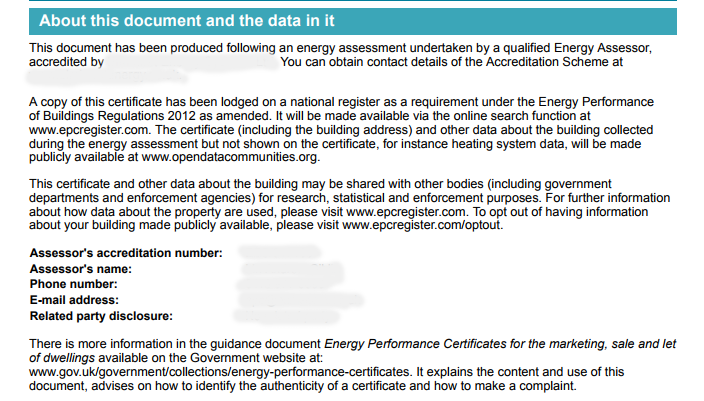 The EPC’s final page begins with basic information about the EPC, including the date of assessment and the assessor and their accrediting body. Environmental impact
The EPC’s final page begins with basic information about the EPC, including the date of assessment and the assessor and their accrediting body. Environmental impact 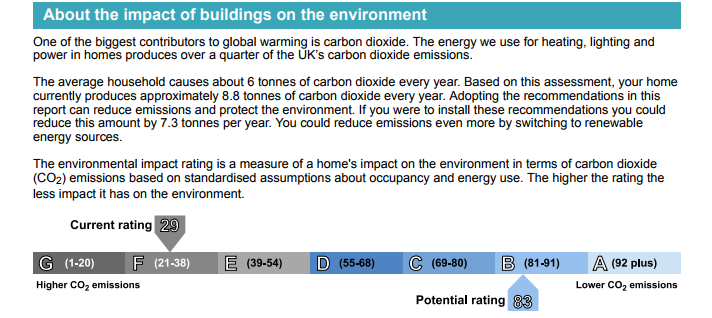 environmental rating which is a measure of a home’s impact on the environment In terms of carbon dioxide (C0s) emissions. The current rating for the home is 29, which means it has a high C02 emissions, however the potential rating for this property could be 83, which would significantly lower C02 emissions. " width="712" height="318" />
environmental rating which is a measure of a home’s impact on the environment In terms of carbon dioxide (C0s) emissions. The current rating for the home is 29, which means it has a high C02 emissions, however the potential rating for this property could be 83, which would significantly lower C02 emissions. " width="712" height="318" />

To get an EPC, you need to speak to a qualified home assessor. This depends on where you live.
In England, Wales and Northern Ireland, only accredited domestic energy assessors can produce valid EPCs. You’ll need one of these assessors to produce an EPC certificate for you.
If you’re selling or renting your home through an estate agent, they may be able to arrange for the EPC to be completed for you.
In Scotland, only organisations approved by the Scottish Government can produce valid EPCs. You’ll need one of these organisations to produce an EPC certificate for you.
If you’re selling your home through a selling agent, you should ask them to arrange for a Home Report to be made. This report includes an energy report and EPC.
Energy reports can only be produced by chartered surveyors registered with RICS.
Getting an EPC certificate can cost between £60-£120. Remember that if you’re selling or renting out your home, you need an EPC otherwise you may be issued with a fixed penalty charge of £200.
How much an EPC costs can depend on:
Assessors may have different fees too, so it’s worth getting a number of quotes from an accredited assessor or organisation to find the best deal.